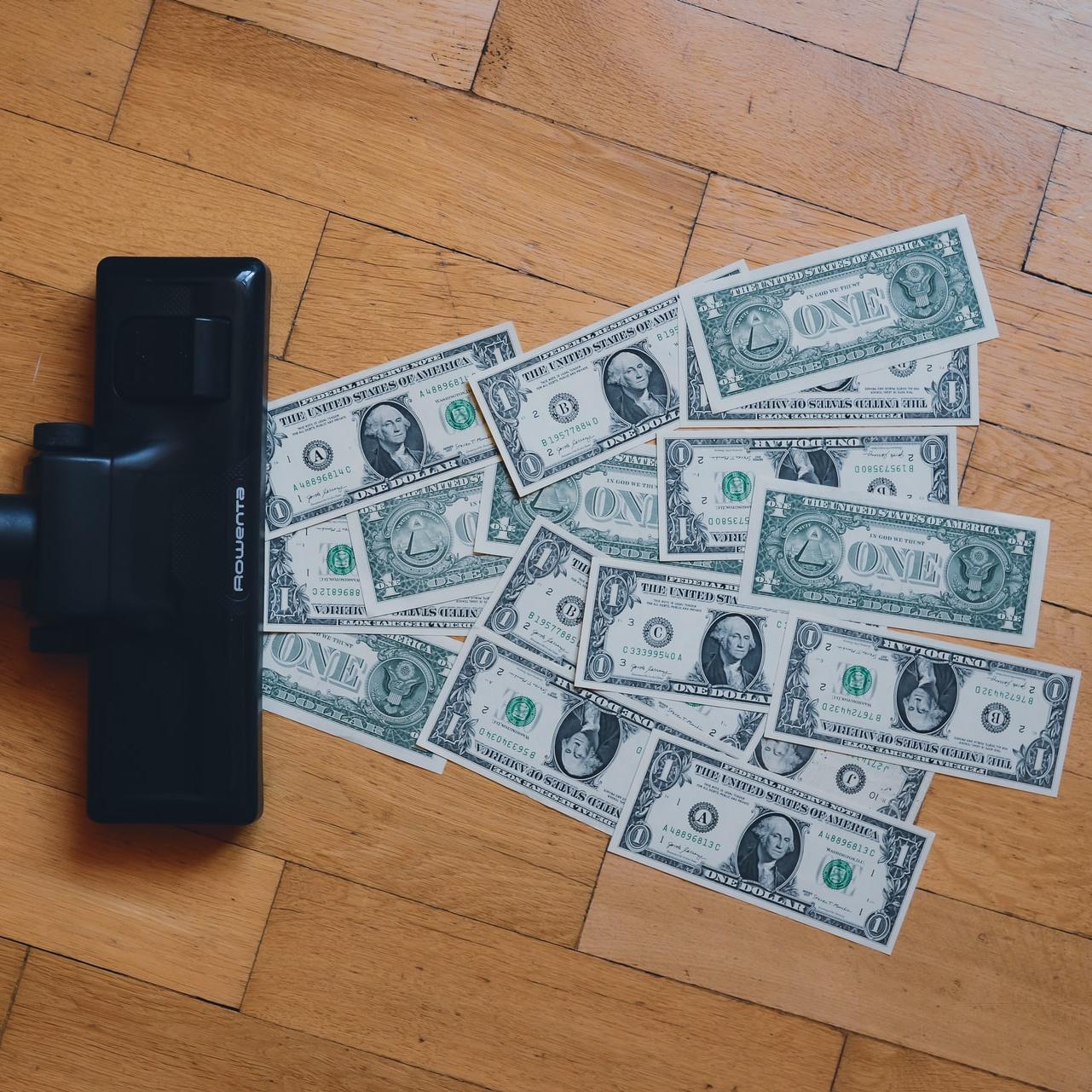We’re Being Played When It Comes to Inflation, Says Corporate Watchdog


With prices rising 8.5 percent over the past year, it’s an understatement to say it’s scary out there for many Americans as they face difficult budget choices day-to-day due to inflation. But a recent report from the watchdog group Accountable.US shows that for many companies, especially retailers, these are actually halcyon days unlike anything seen in decades.
Past history suggests the U.S. president currently residing in the White House will receive the lion’s share of blame over any economic jitters, including inflation (witness Richard Nixon, Gerald Ford and Jimmy Carter during the 1970s and George H. W. Bush in 1992). But the numbers don’t lie: The current volatility is not only about supply chain disruptions, the war in Ukraine or the pandemic, but it's also about America’s largest retailers doing far more than only passing along their costs to consumers.
Editor's note: Be sure to subscribe to our Brands Taking Stands newsletter, which comes out every Wednesday.
Researchers at Accountable.US concluded that the largest U.S. retailers together reaped 2021 profits that surged to $99 billion. Meanwhile, payouts to shareholders in the form of stock buybacks and dividends reached $79 billion last year, about a $45 billion increase from 2020.
“Many of the nation's largest retailers are exploiting the situation to inflate their profits,” independent journalist Judd Legum wrote in his Popular Information newsletter, noting that during 2021, U.S. corporate profits in total roared upward by 25 percent to more than $2.8 trillion, an increase not seen since 1976.
If you don’t believe the numbers, listen to corporate earnings reports. The researchers at Accountable.US show how the terms CEOs and CFOs have used during earnings calls are largely couched and toned down; after all, no one wants to admit they are price gouging or taking advantage of what’s happening in global markets. But terms such as “pricing strategy” and describing inflation as a “major opportunity for us” to “adjust” (i.e., “increase” prices) are on the record. Those aren’t terms we see on store signs or online shopping portals.
As Accountable.US sums up, “Overall, companies in the S&P 500 saw near-record operating margins in 2021 because they were able to raise prices.” Retailers in particular benefitted as consumers opened their wallets after spending the previous year sheltering in place. Retail spending so far is projected to increase by 6 percent to 8 percent during 2022.
The companies on which Accountable.US focused reads like an A-to-W list of America’s largest retailers, with the report centered on the actions of retail brands such as Amazon, Costco, CVS, Dollar General, Home Depot, Kroger, Lowes, Target, TJX Companies and Walmart.
Not all companies are using inflation as a ruse to squeeze consumers. Take the mini market staple, AriZona iced tea, which is still 99 cents and has been for almost 30 years. The company’s founder just assured NBC’s Today show that the price will remain the same; incidentally, his net worth is estimated at about $3 billion.
Viral stories of AriZona aside, however, the news networks are for the most part offering their readers and viewers a much different narrative about inflation.
“There is a lot of coverage of inflation in the media. Why do you seldom hear about the relationship between price increases and corporate profits? Well, many media outlets rely on advertising from the same corporations that are increasing prices,” Legum observed.
Image credit: olieman.eth via Unsplash
United Airlines CEO’s Straight Talk on Sustainability Irks Competitors


United Airlines CEO Scott Kirby admits to angering some of his competitors when the carrier committed to becoming 100 percent green by 2050 without relying on traditional carbon offsets.
Battery-powered aircraft and tree planting are among the sustainability bubbles Kirby burst during an interview at the Reuters Responsible Business USA event in Brooklyn, NY earlier today.
“I just can’t stand the hypocrisy and putting a fig leaf over it and pretending to solve it as a marketing initiative when you know you haven’t,” Kirby told an audience of corporate sustainability professionals.
On carbon offsets, Kirby said there was not enough room on earth for the forests required to offset emissions from commercial aviation. “We’d starve to death” due to the lack of available land for food crops.
While acknowledging that United has invested in zero-emission aircraft engine technology, Kirby said the only plausible use would involve short-haul routes.
“The most emissions are big airplanes flying long distances,” he said, countering that the weight of batteries would preclude this a for New York to India flight with 300 passengers.
Carbon sequestration and sustainable jet fuel are far more feasible solutions, but each requires political support that is challenging to achieve with lawmakers focused on the next election cycle rather than the long-term health of the planet, said Kirby, a father of seven who talks about his commitment to leaving a healthy planet for his children.
Wind and solar faced similar challenges decades ago but have since been commercialized and are working at scale as replacements for fossil fuels, said Kirby.
“It becomes cost competitive but not on day one,” Kirby said of sustainable jet fuel, which is “almost doesn’t exist today” and is challenging to produce with current government subsidies in place encouraging refiners to include ethanol in gasoline.
President Biden’s failed Build Back Better bill, even when pared down, would likely include provisions encouraging sustainable aviation by subsidizing greener jet fuel.
On carbon sequestration — the process of capturing and storing atmospheric carbon dioxide — Kirby is more optimistic.
“Carbon capture is the only scalable technology that we have today that can actually solve the climate problem,” he said. “It’s just a question of, ’Are we as a globe willing to spend the money?’ A solution more probable in the short term is setting a price for carbon emissions, he said. “My view is that the simple way to solve this problem is a carbon tax.”
United’s chief executive also aimed criticism at its primary regulator, the U.S. Federal Aviation Administration, for exacerbating the climate crisis by failing to eliminate “zig-zag” flight routes rather than the shortest distance from point to point.
“The biggest low hanging fruit is air traffic control. We still fly highways in the sky… laid down 100 years ago. We waste fuel by not flying in a straight line, and we could.”
Image credit via United Airlines/3BL Media
Ceres, SEC Leaders Talk About the Bridge to Expanded Climate Disclosure


In the shadow of the Brooklyn Bridge today, corporate sustainability professionals received an update from the head of the U.S. Securities and Exchange Commission (SEC) on which companies would be required to disclose so-called Scope 3 greenhouse gas emissions.
Of the 1,600 large U.S.-based public companies characterized as “accelerated filers” by the SEC, “a fair number” would have to report on Scope 3, SEC chair Gary Gensler said during a Reuters sustainability conference. Scope 3 encompasses not only a company’s own emissions, but also those of third-party partners both upstream and downstream.
A public comment period began in March when the SEC published proposed climate disclosure rules. More than 5,800 comments have been filed as of press time.
“Companies and investors alike would benefit from clear rules of the road,” Gensler said. “We’re trying to build upon that.”
Pushback over rules mandating Scope 3 emissions has clearly irked some business leaders pushing for accountability in the face of a looming climate crisis.
“We have a bus coming at our kids. Climate is that bus that’s coming fast and furious, and we’ve got to get in front of it,” said Mindy Lubber, CEO and president of the sustainability nonprofit Ceres, adding that an automobile rental company needs to be held accountable for Scope 3 emissions for its 5,000-car fleet. “All the SEC is saying is measure.”
“Data is a start. We’ve got to move at a pace and speed we’ve never done before,” Lubber continued during an on-stage interview at this week’s Reuters Responsible Business USA event in New York.
Threats of potential litigation aimed at the climate-related disclosure rules should not dissuade the SEC from action, said Lubber, who both applauded companies setting science-based targets and warned against making empty gestures that give the appearance of climate action.
“Words and small steps are equivalent to nothing,” she said. “Over the past few years, we’ve seen a revolution from cute green teams at the office to thousands of companies committing to net zero.”
Image credit: Magnus Andersson via Unsplash
Numbers Don’t Lie on Diversity and Inclusion, Or Do They?


With regard to almost anything — your bank balance, your IQ score, the number on the bathroom scale — “they” say that numbers don’t lie. But when it comes to a corporation’s diversity and inclusion evaluation, numbers have a way of representing less of what reality reflects and more what a corporation wants the public to perceive it to be.
TriplePundit recently examined three companies' demographic profiles and found varying indices being reported, such as dollars and cents and participation rates versus people. Only one company boldly asserted its diversity by counting noses.
First, the good news: Siebert Williams Shanks (SWS) is an independent non-bank financial services firm with headquarters in New York and Oakland. SWS has more than 125 employees spanning 19 offices in the U.S.
As the largest women- and minority-owned investment banking firm in the U.S., SWS is 61 percent women-owned, 92 percent minority-owned, 57 percent Black, Indigenous and People of Color (BIPOC), and 32 percent of the labor force is female.
And its successful efforts to achieve diversity have not gone unnoticed in the industry. SWS was recently named the International Finance Review’s (IFR) Inaugural U.S. Diversity & Inclusion House of the Year. SWS was ranked as the top D&I firm in co-manager roles on U.S. investment-grade transactions in 2021 and was named senior manager on the Environmental, Social and Governance (ESG) Green Deal of the Year with Newark Public Schools.
Adding credence to the notion that a diverse workforce is good business, its corporate client base includes 74 companies within the Fortune 100. SWS is also ranked as a leading co-manager of investment-grade corporate debt for the past 10 years. Under the leadership of CEO and President Suzanne Shank, SWS was the first MWBE (minority- and women-owned business enterprises) to rank among the top 10 U.S. underwriters of municipal bonds.
Is it due to the manageability of a smaller workforce, as opposed to a Google or Amazon, that SWS is able to produce such good results? Maybe. But consider that what is being reported is what is important — the actual percentage of people who occupy the chairs, based on race and ethnicity descriptors in line with those utilized by leading data analysts.
Google reports dollars and time spent on D&I. In 2014, Google.org launched a Gender Equality Portfolio that was said to have spent $55 million to create economic empowerment for women and girls by 2020. In 2015, Google.org announced a racial justice portfolio that by 2020 was predicted to spend $104 million in grants and 25,000 pro bono hours to advancing equality. In 2017 it was announced that the supplier diversity program had spent $1 billion cumulatively to promote minority-, women-, veteran-, disabled- and LGBTQ-owned businesses. In 2019, Google reported that 50 percent of its employees had completed unconscious bias training. (Was this a milestone, or why just 50 percent?)
And according to the report, 4.4 percent of Google’s U.S. employees were “Black+,” which includes workers who identify as more than one race, one of which is Black. That is far below the national average of 12.3 percent, and 9.1 percent for digital publishing and search companies, according to the Bureau of Labor Statistics.
Black "plus?” Google collects data for Asian and Latinx also. The problem with these unique categories is in not being able to contrast those demographics to other entities like the U.S. Census Bureau or the Bureau of Labor Statistics that don’t use similar descriptors. The 2021 report includes a legend explaining what these “plus” categories include.
In early March, a former employee at Google sued the company, claiming it systematically discriminated against Black workers by placing them in lower-level jobs, underpaying them and denying them opportunities to advance.
It will be interesting to see what numbers Google presents to legally defend itself.
Amazon is a similar hulking giant when it comes to having a large workforce — some 1.6 million employees globally as of 2021. And Amazon has its own employee complaints such as low pay, unequal opportunities for advancement, short break times and lack of paid time off for injured workers.
Recently, in an amazing David and Goliath moment, Amazon workers at their Staten Island warehouse location won the vote to unionize. It says something about the earnestness of the employee base to improve working conditions and realize this type of victory over a well-funded behemoth.
Workers are demanding an hourly wage of $30, up from a minimum of just over $18 per hour offered by the company. The estimated average wage for the borough is $41 per hour, according to a similar U.S. Census Bureau analysis of Staten Island’s $85,381 median household income.
And although Amazon was recently voted the No. 1 place to work by LinkedIn in terms of advancement, demographics show that while more than 60 percent of the hourly associates at the Staten Island facility were Black or Latino, most of its managers were white or Asian.
No, the numbers don’t lie, but accuracy depends on asking the right questions. Corporations would take a giant leap toward authenticity in their corporate responsibility reporting by standardizing basic goals and measurements.
Image credit: Christina Morillo via Pexels
Salesforce Ramps Up Investments in Global Fight Against Climate Change


Salesforce is giving a total of $11 million to 12 global nonprofits in the first round of donations from its $100 million Ecosystem Restoration and Global Justice Fund. The donations, which were announced April 12 at the company’s Net Zero Summit, support key programs that have embarked on various strategies to tackle climate change, including ones that enhance natural carbon sinks, protect biodiversity and create green jobs.
“We believe that philanthropy can be a powerful tool in fighting climate change,” said Naomi Morenzoni, senior vice president of philanthropy at Salesforce, in a public statement. “Climate change impacts everyone, and it disproportionately affects the world’s most vulnerable communities. Through our philanthropic donations, we aim to support organizations that work with local communities to find meaningful, nature-based climate solutions.”
The organizations receiving the funds include American Forests, the Arbor Day Foundation, Conservation International, Fundación Natura, the National Fish and Wildlife Foundation, One Tree Planted, Restor, Save The Bay, the Nature Conservancy, the Ocean Foundation, Wetlands International, and the World Resources Institute.
A shift from traditional philanthropy
“Our investments are focused on locally-led innovation and supporting projects with multiple impacts,” Morenzoni told TriplePundit. “We will be measuring the impact of these donations through metrics such as number of trees and mangroves planted, metric tons of carbon dioxide reduced, and the economic value of ecosystem services provided.”
In vetting these organizations, “We worked with them to understand what kind of support would be most meaningful and where they would be able to infuse our capital,” Morenzoni said.
She added that Salesforce looks to support “trusted organizations that work closely and have longstanding relationships with local communities.”
“We spend a lot of time doing deep listening with our partners to understand where our dollars can have the greatest impact,” Morenzoni explained. “We also have regular check-ins with our partners to learn how projects are going and assess our investments.”
Philanthropic donations generally provide “risk-tolerant capital” to nature-based climate change solution projects, about half of which fail, Morenzoni claimed.
“Philanthropy can play a distinct role in supporting early-stage innovations that have immense potential, but no guarantee,” she said. “The projects may not always pan out as expected, but if they support the understanding of what works or doesn’t work when it comes to climate innovation, it’s helping to move us forward.”
Supporting the climate change fight on the ground
Jad Daley, president and CEO of American Forests, said the Salesforce donation is “game changing” for the nonprofit in several ways. For example, the funds will allow for the extension of the organization's Tree Equity Score, which calculates how much tree canopy and surface temperature align with income, employment, race, age and health factors in the United States. In addition, American Forests said it will develop a Tree Equity Score program for the United Kingdom to serve as a pilot for other countries. Other initiatives include the opening of a new Hawaii field office to accelerate reforestation efforts there, as well as expanded development of climate-informed reforestation of lands lost to forest fires across the western U.S.
“We are also using Salesforce’s leadership to draw in other corporate partners and philanthropies who share these goals,” Daley told TriplePundit. “That support covers a wide range of needed investment, from science and planning, workforce development, and coalition building to funding the actual costs of tree-planting projects.”
Further, the funds from Salesforce will enable the World Resource Institute’s (WRI) Global Restoration Initiative to expand its efforts to support small- and medium-scale enterprises (SMEs) working in sustainable agriculture and forestry.
“Less than 10 percent of the SMEs in developing countries get the capacity and capital they need, compared to more than 60 percent in developed nations like the United States,” said Sean Dewitt, WRI’s global restoration initiative director.
A focus on climate action in the Global South
WRI launched its Land Accelerator in 2018 to build the capacity of hundreds of entrepreneurs working to restore degraded forests and farmland across Africa, South America and South Asia. So far, Land Accelerator graduates have received more than $2 million in seed capital funding, improved the livelihoods of more than 10,000 people and brought 30,000 hectares under restoration, Dewitt said.
“With local communities managing more than 9 percent of land across India, and Indigenous people safeguarding 12 percent in Brazil, organizations that engage these communities will be at the forefront of the growing restoration industry,” he added. “Salesforce funding allows us to deploy the Land Accelerator to target micro enterprises in India and mid-growth SMEs in Brazil.”
Both Dewitt and Daley said their nonprofits will be communicating with Salesforce on a regular basis to report on the progress of their work addressing climate change.
Within its own ranks, Salesforce says it is tying executive bonuses to progress made in advancing the company’s initiatives in sustainability and equality. In February, Salesforce announced that it would tie a portion of executive variable pay for executive vice presidents and higher within its organization chart to four environmental, social, and governance (ESG) measures to build greater accountability and accelerate the company’s various social impact and sustainability initiatives. For this fiscal year, the measures at Salesforce focus on equality and sustainability.
Image credit: Ron Lach via Pexels
What Our Nonprofit Partners Are Doing to Support People Impacted by the War in Ukraine - and How You Can Help


According to the UN, 6.5 million Ukrainians have been displaced within Ukraine, and according to the UN Refugee Agency (UNHCR) more than 4 million people have been forced to flee the country since the invasion began on February 24, making this the fastest-growing refugee crisis in Europe since World War II. The scale of the unfolding humanitarian crisis in mind-numbing: experts estimate that 12 million people will be in need of humanitarian assistance.
At Cisco, we have long focused on helping vulnerable populations – those unhoused or displaced by conflict and natural disasters – meet their critical needs. We leverage our people, technology, and financial resources to support our nonprofit and non-governmental partners that are working tirelessly to help those displaced and in need.
Cisco employees have donated nearly $1M to 19 nonprofit organizations featured in our Ukraine Humanitarian Assistance Fund; with Cisco Foundation matching, we have raised nearly $1.9 million in total giving. In addition, Cisco has donated $1M to the UNHCR to support their relief activities and support services for Ukrainians fleeing the country, while our Cisco Crisis Response team is working with UNHCR to connect refugee centers and support hubs. The Cisco Foundation has also allocated $1M in donations to support local nonprofits efforts in and outside of Ukraine.
Here is more information on what some of our key nonprofit partners are doing to support those in need:
- Americares has Emergency Response Teams on the ground in Poland and Romania, assessing health needs and coordinating shipments of medicine and supplies for Ukraine. Americares response is focused on delivering medicine and medical supplies, supporting health services, and providing mental health and psychosocial support for refugees and survivors who have experienced trauma.
- Mercy Corps is on the ground in Ukraine, Romania, and Poland, providing funding and support to local organizations in their relief efforts and delivery of humanitarian aid. Mercy Corps is working with partners to provide emergency cash assistance, allowing those affected to meet their most pressing needs as well as providing up-to-date information in multiple languages to families on the move.
- Save the Children has been operating in Ukraine since 2014, delivering essential humanitarian aid to children and their families. Save the Children is in Ukraine, Poland, Romania, and Lithuania prioritizing cash and voucher assistance so families can purchase food and other essentials. Save the Children is also supporting the immediate needs of girls and boys with child protection, psychosocial support and education programs.
- UNHCR is assisting internally displaced persons (IDPs) inside Ukraine, and coordinating the delivery of protection, assistance, and solutions for refugees in collaboration with national authorities in neighboring countries. Together with UNICEF, UNHCR is setting up Children and Family Support Hubs with key protection and social services for children and families with specific needs.
- World Central Kitchen (WCK) began serving hot meals within hours of the initial invasion of Ukraine, and quickly set up at the eight border crossings with Poland. Since then, WCK’s Chefs for Ukraine response has grown rapidly, and is distributing nourishing food and almost 250K meals per day across 7 countries, including Ukraine, Poland, Hungary, Moldova, Slovakia, Romania, and Spain. In addition to their field kitchen, WCK is working with local restaurants, caterers, and food trucks to provide fresh and comforting meals at border crossings, reception centers, shelters, and other locations along their journey. WCK is also distributing bulk food product including produce and dry goods in Ukraine to supplement the strained food supply chain.
If you are a Cisco employee, you can help by donating to the Ukraine Humanitarian Assistance Fund in Bright Funds. If you do not work for Cisco but would like to help, we have an external Ukraine Humanitarian Assistance Fund.
Also, please consider making a direct donation to one of the organizations listed above. Cash donations enable nonprofits to purchase the supplies and services they need, and to support the most immediate needs of the communities they serve.
View original content here and in the 3BL Media newsroom.
image credit: Mathias P.R. Reding via Pexels
Six Things to Know About the Current State of the Plant-Based Protein Sector


Plant-based protein companies keep rolling out new products, and food tech companies keep making what was once unpalatable actually possible to nosh on. The result is an industry still poised for growth, a trend the Good Food Institute reaffirmed with its recent series of new reports that covered this industry in great depth. As TriplePundit perused through the reports, here are six big stories that we gleaned from GFI’s copious amount of research.
Investment keeps moving along, big time
If anything, the amount of money plunged into plant-based protein companies shows that this market will not be going away any time soon. Last year, almost $2 billion was invested in companies making plant-based meat, egg and dairy alternatives. That amount in 2021 alone represents about 30 percent of all-time investments in plant-based protein products when going as far back as 1980.
Growth in sales of plant-based protein is steady
Last year in the U.S., GFI estimated that plant-based food sales grew 6.2 percent. That may seem like a tepid number at first glance, but considering supply chain snafus, inflation and the global pandemic, that is a rate in growth that many sectors would envy. Such growth is three times faster than the total amount of food sales at large. While the sales of plant-based meat alternatives held steady during 2021 compared to the previous year, milk alternatives grew 4 percent. As for plant-based egg substitutes, this small segment witnessed a huge surge in 2021, as in 42 percent over the previous year to $39 million in sales.
The taste is getting there, and new technologies are sorting out the texture
True, these aren’t your veggie burgers of the early 2000s, and now that companies have been able to find that blend of pea protein, vegetable fibers, soy, heme, all of the above or none of the above, the next frontier will be the ability to mimic the texture of meat and other animal products. On that point, companies have been able to improve how they apply food technology. One way is through shear-cell technology, a process that creates a more fibrous and chewable texture through applying pressure to plant proteins through two rotating cylindrical plates. The other is by turning to 3D printing, which can result in recreating (gulp!) food products that are similar to the makeup of whole-muscle meat cuts.
Plant-based pork options are definitely now a thing
For several years, much of the focus on plant-based protein was on finding alternatives to beef and chicken, which makes sense considering the potential fiscal sweetener of landing a contract with a massive fast food chain or food service company. But across much of the world, the meat of choice is often pork for a bevy of reasons: cost, versatility, and its relative efficiency when it comes to raising and production. The outcome could result in a long-term market bonanza, and companies are starting to get it. Along with Impossible Foods, the brands that have recently rolled out plant-based alternatives to pork products include Field Roast, Wicked Kitchen, Hungry Planet, Horray Foods and Heura.
Price parity is on the horizon
As prices for plant-based protein shift to the point at which they will be more competitive with animal-based products, the possibility of greater market share becomes even more promising. Data from 2021 suggests such a trend is already underway, and dovetails at a time when the price of meat-based products has increased by more than 10 percent. The companies that have cut prices, or say they have plans to make such reductions, include Impossible Foods, Beyond Meat and OmniFoods.
It’s a market for big brands, and more multinationals want in
Amongst the 10 largest plant-based protein brands based on U.S. sales, some independent names stand out: Beyond Meat, Dr. Praeger’s, Impossible Foods and Tofurky. But large multinationals comprise the rest of the list, including U.S.-based Conagra (Gardein), Kellogg (Morningstar Farms) and Kraft Heinz (Boca); Maple Leaf Foods (Lightlife) of Canada and Monde Nissen (Quorn) of the Philippines round out the list. Watch for even more global players to jump into this sector, as more large companies are seeking some plant-based skin in the game with new product launches, a roster that includes Nestlé, PepsiCo, Tyson and Korea’s soy and tofu giant, Pulmuone.
Image credit: Milada Vigerova via Unsplash
As the IRS Keeps Targeting the Poor, Companies Gain Opportunities to Step Up and Assist Marginalized Citizens


If you live in the U.S., your federal taxes are due today, offering many grim reminders. Here's one of them: While many of the largest and most profitable U.S. companies pay little or even zero income taxes and the wealthy have the means to evade paying their share, the federal government is continuing its war on the poor. One example of failure within U.S. federal policy is the ongoing practice of the IRS (Internal Revenue Service) disproportionately auditing poorer U.S. households.
Hence there’s an opportunity for companies within and linked to the financial sector to make good on any of their social impact agendas, notably as it’s currently Financial Literacy Month. For many families grossing $25,000 a year or less, how can the latest no-cost fintech apps or campaigns to improve how citizens approach personal finance do any good if there’s the specter of an IRS audit on the horizon? As more than half of Americans are estimated to have less than three months of savings to cover an emergency, an envelope in the mail from the IRS could be as frightening as an emergency room visit or the sudden need for a car repair. Bottom line: The less a person makes, the less likely he or she has an accountant on speed dial.
Going back to the threat of an IRS audit for working families: Current evidence suggests that the IRS has no plans to curb such plans any time soon. In fact, the Transactional Records Access Clearinghouse (TRAC) at Syracuse University found that audits of wage-earners making $25,000 or less has increased by more than 25 percent so far this year when compared to the 2021 tax season.
“If IRS continues at this same pace for the rest of this fiscal year, audit rates would inch up to 13.5 per 1000 returns — slightly higher than the phenomenally high rates that occurred last year when IRS audited the poorest families claiming an anti-poverty earned income tax credit at five times the rate for everyone else,” concluded TRAC’s researchers.
The problem is starting to score the attention of Congress, with Sen. Elizabeth Warren (D-Mass.) and Rep. Judy Chu (D-Calif.) among the leaders calling out both the U.S. Treasury and the IRS for these distorted audit rates.
Much of the problem lies in the feds’ decisions to slash the budget of the IRS over the period of several years, a trend that occurred during both the Barack Obama and Donald Trump administrations. But few observers are noticing as the IRS keeps losing staffers not through mass layoffs, but through attrition.
“The last time the IRS had fewer than 10,000 revenue agents was 1953, when the economy was a seventh of its current size. And the IRS is still shrinking,” Paul Kiel and Jesse Eisinger wrote for ProPublica back in late 2018.
Another problem is the lack of transparency as to how the IRS is conducting its audits now. “While the [Joe] Biden administration’s American Families Plan Tax Compliance Agenda committed to not increasing the rates of audits for those earning less than $400,000 annually, there is no consistent public release of audit data or a plan to release audit data, making it virtually impossible to monitor compliance with this commitment,” Warren and Chu wrote last month.
Years of bad headlines along with how the tax collection agency has been portrayed in popular culture have given the IRS a brand reputation that ranks about as high as the Ford Pinto and New Coke. Nevertheless, it’s clear having a crew of auditors that is smaller now than when Dwight Eisenhower was president — even with the transformation of technology now available at hand — makes no sense. The current head of the IRS, Charles Rettig, told Congress earlier this month that the federal government is losing about $1 trillion in paid taxes a year. But trying to extract that amount from hourly wage workers who are rightfully claiming a federal tax credit is the financial equivalent of getting blood from a stone.
Going back to financial inclusion, the IRS’s continued reign of auditing terror opens a door to financial and professional services companies. Offering support for poor families who get such a nasty-gram from the IRS would not only offer families relief, but also provides an engagement opportunity for companies as they allow their employees to tackle some much-needed community work within the neighborhoods in which they live and work.
Image credit: John Tyson via Unsplash
Evrnu Pushes the Apparel Industry to Embrace the Circular Economy


Among its many environmental impacts, it’s estimated that the fashion industry consumes about 10 percent of water used by industry worldwide. While some companies are tackling the adverse impacts of the global fashion industry with the type of raw materials they use, and others look to revamp one or more stages of the textile manufacturing process, Seattle-based Evrnu says it is creating systemic change. The company has recently launched what it claims to be the world’s first high-performance recyclable lyocell material made from 100 percent textile waste.
Evrnu’s mission dates back to when its co-founder, Stacy Flynn, spent a month in China, where she noticed the effects of toxic wastewater from textile factories on local communities. Founded by Flynn and Christopher Stanev, both former employees of big-name textile companies, Evrnu aims to address textile waste and pollution as a whole. With its textile engineering system, NuCycl, the company says it can generate its NuCycl r-lyocell fabric using only cotton textile waste as its base material.
The company's manufacturing process begins with the sorting of textile waste, then shreds it and in the end, purifies it. The recycled textile pulp is then transformed into a highly durable ‘r-lyocell’ fiber through a closed-loop method. The final fiber, says Evrnu, is one of superior durability, and can replace and even outperform virgin cellulosic and plastic-based fabrics, which account for 90 percent of all current textile fibers.
Evrnu recently debuted this material with a T-shirt designed by Carlos Campos; in the past, the company has worked with brands such as Levi Strauss that explored using waste materials to manufacture apparel.
How Evrnu disrupts the textile manufacturing process
Evrnu’s lyocell product is regenerative as it is made entirely from cotton textile waste.
For decades, man-made cellulosic fibers have been generated from dissolved pulp, often from virgin wood. Evrnu’s technology uses recycled textile pulp in the place of virgin tree pulp and processes it into lyocell. In contrast to synthetic fibers including nylon and rayon, which have a chemical makeup entirely different from wood-based cellulose, Evrnu’s lyocell product can be recycled multiple times as its structure has not been altered. That is in contrast to synthetic fibers such as rayon and nylon, which cannot be recycled due to the fabrics’ chemical structure. In industry speak, the process Evrnu uses is a non-derivative method, while conventional materials like rayon and nylon rely on a derivative chemical process.
The result is a bio-based alternative to polyester, nylon and other man-made cellulosic fibers. The resulting fabric also provides the apparel industry a means of reducing carbon emissions and plastic shedding. Evrnu adds that its lyocell material exceeds the performance of the polyester and man-made cellulosic fibers currently available.
Rethinking how fabrics are made
Evrnu sees discarded textiles as an untapped natural resource. The company designed its NuCycl technology with the goal of growing the global textile industry, and doing so sustainably and responsibly, by accessing the full potential of resources that already exist and do not need to be extracted. As estimates suggest that the world’s fashion industry generates about 92 million metric tons of waste annually, Evrnu says it is helping to reduce this global problem by turning what was once simply something to look at and then discard as waste into a renewable resource.
By diverting that textile waste from landfills, Evrnu’s process also prevents the leaching of chemicals and microfibers into the environment. The company’s system not only reduces the amount of energy and chemicals required during the dyeing process, but it is also highly water-efficient — in fact, it uses 98 percent less water than what is needed to manufacture fabric out of cotton, an Evrnu representative explained in an email exchange with TriplePundit.
Pushing the apparel sector into the circular economy
Evrnu’s current plans are to become a player in the global apparel sector’s value chain. Its current plan is to license out the company’s technology with the goal to ramp up the adoption of its fabric and to allow the NuCycl manufacturing process to scale up. To date, the company says it has raised $29 million, with the number expected to increase to $31 million by the end of this month. As part of its long-term strategy, the company is currently building a commercial demonstration factory in the U.S. so it can demonstrate to potential licensees what its technology can make possible. Once completed, the facility will have the capacity to process 17,000 metric tons of pulp and 2,000 tons of fiber.
The result of Evrnu’s efforts is a step forward for the circular economy and a bolder effort to divert textile waste from landfills and prevent more chemicals and contaminated water from leaching into the environment. The company joins other brands in their efforts to rethinking how clothing is both purchased and discarded, including Worn Again Technologies, For Days and Everywhere Apparel.
Image credits via Evrnu
The Challenge of Plastic and Achieving Sustainable Packaging


There’s no shortage of data and stories pointing to the impacts that single-use plastics have on the planet. No one entity can take on this challenge alone, so partnerships will be instrumental in shifting society away from excessive packaging and closer to a circular economy.
One such partnership is the U.S. Plastics Pact, a coalition of brands, retailers, government agencies, and nonprofits that seeks the goal of having all plastic packaging be recyclable, reusable or compostable by 2025. A group founded by The Recycling Partnership and the World Wildlife Fund, the U.S. Plastics Pact started in August 2020 as part of the Ellen MacArthur Foundation’s worldwide network of national and regional plastics pacts, which includes chapters across North and South America, Africa, and Europe.
Here in the U.S., the Pact has set several targets to transform plastic packaging by 2025. In addition to that aforementioned goal of all plastic packaging being recyclable, reusable or compostable, the U.S. Pact’s roadmap aims for an average of 30 percent recycled or responsibly sourced bio-based content in plastic packaging by 2025. The group also seeks to ensure that half of all plastic packaging can be recycled or composted by that year.
“Recycling-alone isn’t going to end the plastics waste crisis,” said Emily Tipaldo, executive director of the U.S. Plastics Pact, which includes top consumer goods companies and retailers including Mars, Inc., Coca-Cola, Target and Walmart. “Instead it requires a suite of solutions and collaboration between business, government and civil society.”
One of the overarching challenges is defining what “recyclable,” “reusable” or “compostable” means in the first place. Just as individuals have their own definitions, the nuance applies to governments at all levels, too. “For every locality and state, ‘recyclable’ means something different,” Tipaldo said. As with any industry, stakeholders have to develop a set of consistent standards first.
To that end, the U.S. Pact arrived at one of its first milestones earlier this year: defining the plastic packaging that its members have deemed “problematic and unnecessary.” Some of the materials are familiar to the U.S. public — including PET bottles that are opaque or pigmented; labels that include adhesives, inks or paper that can render the packaging non-recyclable; polystyrene and its cousin, polystyrene foam (or EPS, commonly known as Styrofoam); and PVC, often used in both building materials and packaging. Single-use coffee stirrers, straws and cutlery also appear on the list, unless those items are sold bundled at a retailer or wholesaler.
U.S. Pact members are already making progress on cutting these materials out, Tipaldo said. “66 percent of [business members] are already making plans and are rolling out initiatives to eliminate these materials, such as resins like PVC or polystyrene in plastic packaging,” she explained.
Such scale is crucial to the U.S. Pact’s future success, as those same business members account for 33 percent of plastic packaging by weight in the U.S. Of that collective 5.6 megatons of plastic waste, the top three plastic packaging materials are PET bottles (generally used for beverages), HDPE bottles (often used for milk jugs and personal care products), and multi-material flexible packaging (which includes everything from snack bags and pouches to plastic seals that keep food fresh).
Why does that one-third statistic matter? The fewer types of plastic resins that are used in packaging nationwide, the greater possibility that mechanical plastic recycling — and, more ideally, the advent of a more circular economy — can scale up. Evidence suggests this shift is underway: “Right now, our baseline is that 37 percent of the packaging that is put out by the U.S. Pact’s signatories is now recyclable, reusable or compostable,” Tipaldo said.
Such moves on the behalf of food companies, manufacturers and retailers are crucial if the world hopes to wean itself away from the excessive consumption of plastic. Companies have also had to find ways to innovate due to several recent changes in global markets, including the decision by China and other countries to stop accepting waste from U.S. recycling streams.
That shift was driven by the outcry over loopholes in the Basel Convention, a treaty that dates back to the late 1980s meant to prevent the shipping of hazardous waste to poorer nations. According to critics, the treaty had since become a tool for nations like the U.S. to use developing countries to process waste — and these lower-income nations overall had far fewer regulations to manage the safe disposal of waste when compared to richer nations such as the U.S. “We know that supply is a big challenge,” Tipaldo explained. “A couple of years ago when there were changes being made to the Basel Convention, they had the unintended effect of cutting off recycled plastic trade in a responsible way.”
Still, the work of the U.S. Plastics Pact is beginning to show how the largest companies in the U.S. are rethinking their packaging. Mars, for example, eliminated 98 metric tons of waste by removing the outer plastic wrap from the boxes of M&M’S sold in movie theaters and retail outlets like Walmart and Target; the company also redesigned some of the plastic in some of its Orbit-branded gum packaging so that it can be recycled in more municipal recycling streams. Last year, Mars launched a Terracycle project with its Karma pet food brand and is exploring additional programs across its petfood portfolio.
In 2019, Mars committed to making 100 percent of its packaging reusable, recyclable or compostable, including a 25 percent reduction in the use of virgin plastics and piloting new reuse-based business models. The company says it is holding itself accountable by embedding these targets into how it measures annual success, and the top 300 executives at Mars now have remuneration linked to delivering against packaging targets.
“Eliminating packaging waste today is a massive challenge, and Mars is eliminating unnecessary packaging, removing difficult to recycle materials such as PVC, and using recycled content wherever possible,” said Allison Lin, global vice president of packaging for Mars. “But fixing the fundamental issues in recycling plastic packaging cannot be done by businesses alone. Through our partnerships with the U.S. Plastics Pact and other industry leaders, we’re actively working to drive true systems change in support of a circular economy where packaging never becomes waste.”
Working with the U.S. Pact has also pushed more companies to launch new plans to overhaul their packaging, and working with this group also helps companies to level with their stakeholders about how they will prevent their packaging from ending up in landfills.
That shift certainly works for Tipaldo. “Forcing transparency and responsibility into the system is what the U.S. Pact is about,” she said.
This article series is sponsored by Mars and produced by the TriplePundit editorial team.
Image credit: Sigmund/Unsplash